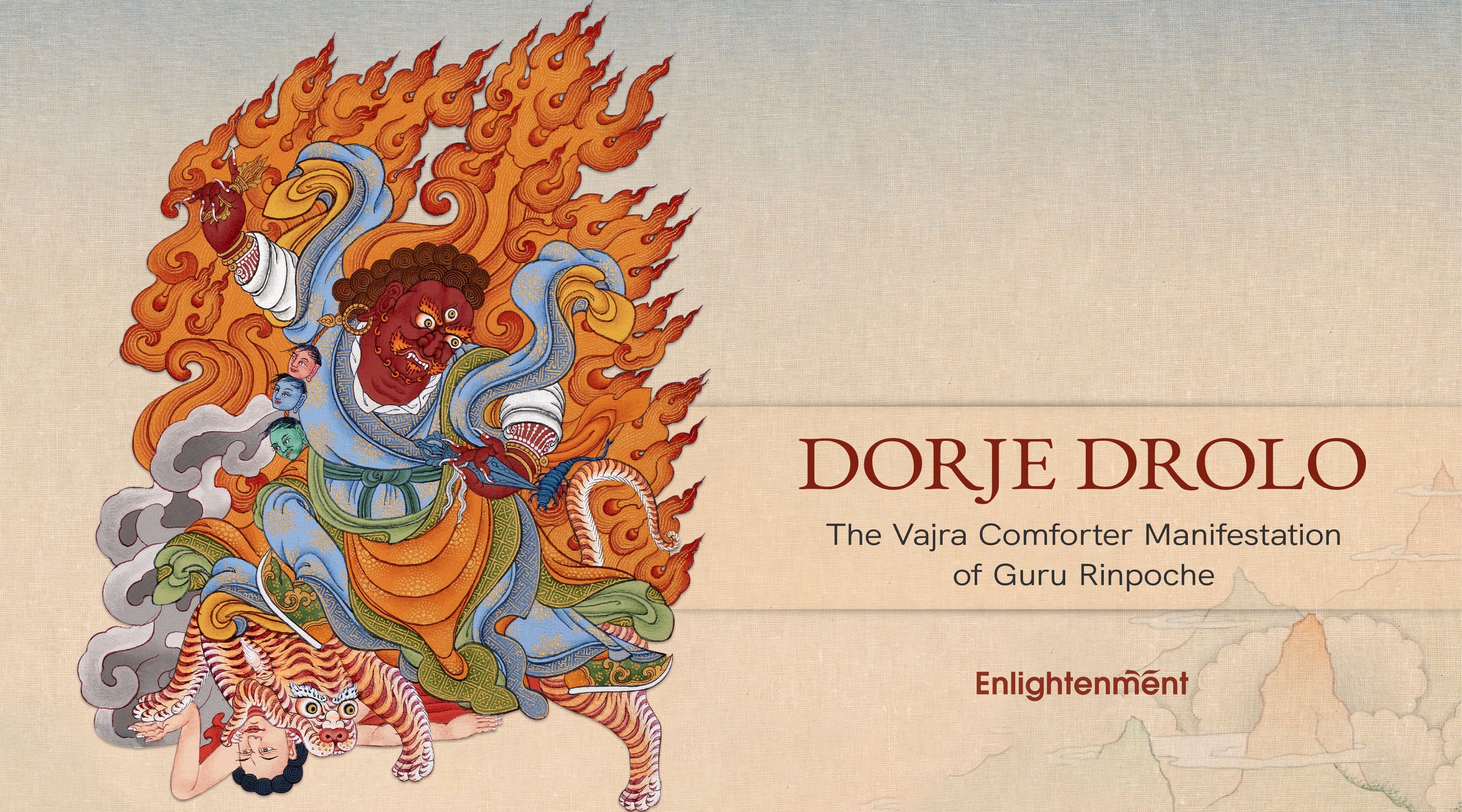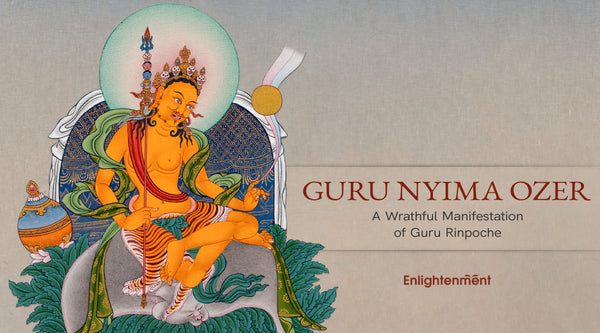Dorje Drolo Embodies Both Compassion and Wrath
Dorje Drolo is an eccentric manifestation among the other eight forms of Guru Rinpoche. He incorporates both the fierce and compassionate energies required to subdue negative forces and obstacles. The name literally means "Vajra Comforter” in Tibetan, and it symbolizes his role in providing comfort and protection through his powerful, unyielding nature. Although wrathful in appearance, the deity is ultimately a compassionate manifestation that helps beings overcome their suffering.
This form is particularly revered in the Nyingma tradition, the oldest of the four major schools of Tibetan Buddhism. Guru Drolo is seen as a protector of the Dharma and a guide for those on the path to enlightenment among the devotees.

Guru Rinpoche, also known as Padmasambhava, had taken eight highly divine forms to restore Dharma and peace. All these manifestations fulfilled various purposes and teachings to the sentient beings throughout their lifetime. The eight forms taken by the Second Buddha are listed below:
-
Dorje Drolo
-
Senge Dradog
-
Lodan Chokse
-
Pema Jungne
-
Urgyan Dorje Chang
All of them have contributed to the rich tapestry of myths and teachings surrounding Vajrayana Buddhism as formidable deities. After all, they represented the highest spiritual attainment and guided their followers to pursue the same, whether with peace or wrath. Guru Drolo used both his peaceful and wrathful prowess to alleviate suffering and escort mortals to spiritual awakening.
The Origin Story of Dorje Drolo
Dorje Drolo and the story of his origin are deeply intertwined with the life and mission of Guru Rinpoche. The "Precious Master" Guru Padmasambhava is credited with introducing Buddhism to Tibet in the 8th century. And according to a legend, when he arrived in Tibet, he encountered numerous hostile forces, both human and supernatural, that sought to prevent the spread of the Dharma.
Hence, the revered Second Buddha chose to take this compassionate yet wrathful form to subdue those malevolent powers and obstacles. This story of manifestation is most vividly recounted in the legend of how Guru Rinpoche subdued the local spirits and deities of Tibet, who were initially resistant to the new teachings.
Among the most significant events is the taming of the malevolent spirits of the haunted regions in Tibet, Guru Padmasambhava manifested as Dorje Drolo in Paro Taktsang, Bhutan.

In this form, Guru Rinpoche is depicted riding a pregnant tigress, symbolizing his mastery over the most potent forces of nature and the samsaric cycle of birth and death. The tigress is believed to represent his consort, Yeshe Tsogyal, one of his two consorts, the other being Mandarva. It is believed that Yeshe Tsogyal assumed this form to assist him in his mission. Together, they pacified the land, binding the local spirits to an oath to protect the Dharma.
His wrathful appearance, wild hair, flaming aura, and fierce expression were the essential parts that instilled fear in those demonic spirits and convinced them to submit. His dynamic, energetic presence is not merely destructive but transformative, converting negative energies into forces for good.
The Symbolism and Iconography of Dorje Drolo
Dorje Drolo is often depicted in the Himalayan art and craft due to his high significance and contributions to Vajrayana. In such art, his appearance is rich in symbolism, each element reflecting his divine purpose. His face is seen twisted in wrath, which signifies the intensity of his compassion—a force so great it can only be expressed through ferocity.
The vajra (thunderbolt) in his right hand symbolizes indestructibility and the power to cut through ignorance. Meanwhile, his dark red complexion and his flaming aura represent the burning away of all impurities.

The pregnant tigress, Yeshe Tsogyal, is a potent symbol of fertility, life, and the natural world's raw power. His riding the tigress represents the union of wisdom and skillful means. Together, they demonstrate the importance of balancing compassionate wisdom with the fierce action required to overcome obstacles. His imagery underscores his role in harnessing and transforming the wild and chaotic energies into disciplined forces that serve the path of enlightenment.
Dorje Drolo in Practice: Invoking the Vajra Comforter
Dorje Drolo is one of the few individually revered deities besides his affiliation with the divine Eight Manifestations. He is particularly invoked in situations where practitioners face overwhelming obstacles, both internal and external. His energy is called upon to cut through fear, doubt, and ignorance, providing the practitioner with the confidence and clarity needed to persevere on the path.
Practitioners of the Nyingma tradition often engage in specific rituals and meditations dedicated to him, visualizing his fearsome form and reciting mantras to align with his energy. These practices are believed to help transform personal and environmental negativities, bringing about peace and stability.

One of the most well-known practices involves a specific mantra associated with Guru Drolo, which is chanted to invoke his presence and protection. This mantra is considered especially powerful in dispelling obstacles and pacifying harmful forces. The mantra is mentioned below:
དྲེལ་བ་དྲག་པོ་ཧཱུྃ་
Drel-wa Drag-po Hu
The meaning of the above-mentioned mantra is broken down here:
- Drelwa: Wrathful one
- Dragpo: Powerful
- Hum: Seed syllable of the deity
The Significance of Dorje Drolo in Tibetan Buddhism
Dorje Drolo holds a significance in Tibetan Buddhism that extends beyond his role as a protector and obstacle-remover. He embodies the dynamic, sometimes paradoxical, nature of the path to enlightenment, where even wrath and fierceness can be expressions of deep compassion and wisdom.
In a broader sense, Duru Drolo represents the need to confront and transform the darker aspects of our existence. His practice encourages practitioners not to shy away from challenges but to meet them head-on with the same fierce energy that he exemplifies. By embodying his qualities, practitioners can find comfort and strength amid the difficulties in life, ultimately progressing further on their spiritual journey.
Conclusion: The Legacy of Dorje Drolo
Dorje Drolo remains a vital figure in Tibetan Buddhism, revered for his ability to protect and guide those on the path to enlightenment. His origin story, filled with dramatic encounters and profound symbolism, continues to inspire and instruct practitioners. As the Vajra Comforter, the deity offers a powerful reminder that even the most formidable obstacles can be transformed into opportunities for growth and awakening.
Whether one is a seasoned practitioner or new to Vajrayana Buddhism, invoking this manifestation of Guru Rinpoche helps provide the strength, protection, and comfort needed to navigate the complexities of the spiritual path. His fierce compassion is a beacon of hope, guiding all who seek enlightenment through the storms of samsara.



1 comment
Manuel Sanchez
I am reincarnated and living in San Antonio Tx. I just awakened at 38.